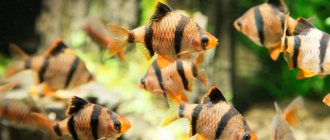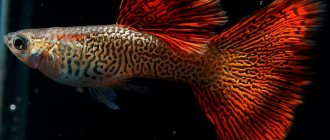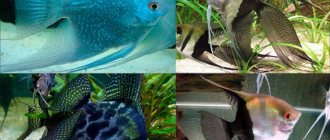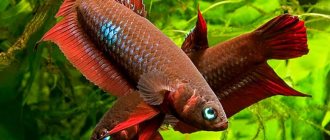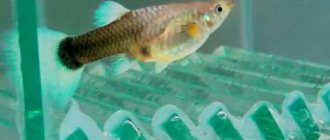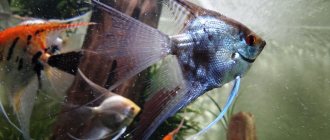External description
The blue dolphin (cichlid) is a common aquarium fish that differs in appearance from any other.
The size of a blue dolphin depends on a number of biological factors. In the wild it lives in South Africa. Blue dolphins reach twenty-five centimeters, while individuals kept in a home aquarium range from eight to twenty centimeters (depending on the volume of water in the tank). The fish is predatory, but this does not interfere with the aquarium and does not create additional difficulties during maintenance. The lifespan of a blue dolphin is fifteen years.
At the beginning of the twentieth century, this fish was found in South Africa, at which time it was described in biological reference books, but distribution and interest appeared only half a century later. By 1968, the blue dolphin was found in aquariums in both Europe and the Soviet Union.
Looking at small individuals, it will be difficult to find similarities with a real dolphin, but an adult fish has an enlarged head, resembling a real dolphin in proportions. The fish has movable parts of the body - large lips and eyes, which makes its distinctive features more attractive.
Blue Dolphin S
Blue Dolphin Cyrtocara moorii MS - size 5 cm.
Synonyms, names in other languages: Haplochromis moorii; English: Hump-head; German: Beulenkopfmaulbrüter
Habitat: lake Malawi. Found throughout the lake
Dimensions: 20 cm, in an aquarium 10-25 cm.
Differences between the sexes: Females often have two black spots on the sides, while males often have a number of dark transverse stripes. With age, the forehead of males becomes huge, and the matte yellow-gray coloring of the upper part of the head contrasts sharply with the general background.
Juveniles are differentiated by sex as early as 3 months. In females, the caudal fin is dotted with reddish dots when exposed to light. Males have a blue tail.
Contents: Aquarium – from 200 l. Temperature 24-26°C, pH 7.3-8.8, hardness 8-25°, water exchange - at least 200 l/h.
Feeding: In terms of feeding type, N. moorii is closer to benthophages, but does not have strict specialization. Along with the larvae of benthic non-vegetables, it eats detritus, planktonic forms, and, less commonly, algae and soft higher aquatic vegetation.
Breeding: they become sexually mature at 8-10 months, but the fish’s body is finally formed only by 14-18 months. From this age it is better to start breeding them. Productivity – 25-150 eggs. The female's goiter is not as pronounced as in pseudotropheus and labidochromis. It can be classified as a throat type, more characteristic of Tropheus. The incubation period lasts 16-25 days. (23-28°C). Artificial incubation somewhat shortens this period. It is advisable to start feeding immediately after incubation (small brine shrimp and cyclops, micromin, tetraphyl, tetramine), due to which the resorption of the yolk sac is stimulated. In case of interruptions in feeding, low temperature (about 20°C), disruption of the hydrochemical composition and flow of water, the fry are instantly “dragged” and sometimes simply die.
Compatibility: Relatively peaceful fish, but territorial; It is best kept in a species aquarium as part of a female-dominated group or in a community aquarium with other sized, peaceful inhabitants of the African Great Lakes.
Additional information: Inhabits coastal biotopes with a sandy bottom, carrying out feeding migrations along the coastline. N. moorii forms stable communities of different ages and intergroups. In nature, one male usually occupies a dominant position, and all the others are subordinate. There are known facts when N. moorii united with other species similar in their habits and fed with them. Often, several H. moorii of different sizes, H. annectens and large specimens of H. rostratus were observed in one flock.
Subject to optimal maintenance conditions, fish can reproduce up to 7-8 years of age. Life expectancy is more than 10 years.
The species can form hybrids with H. venustus and Melanochromis johanni. In the latter case, the hybrids have the form H. moorii; males are dirty blue with 9-12 vertical stripes. The dorsal fin is blue-black. Females are smaller, gray-brown with sometimes appearing stripes of a bluish tint.
Content
The requirements are simple. First, you need to decide on the size of the aquarium. The blue dolphin is not very large in size, but the glass tank should be spacious, since in the wild the fish is not found in small bodies of water. The aquarium decor is standard - the maximum number of imitations of underwater caves, corals and crevices, and the bottom is covered with sandy soil. The main goal is to give the blue dolphin the opportunity to hide from the outside world.
To make your pet comfortable:
- the lighting in the aquarium cannot be dim, the brighter the better;
- water temperature from twenty-two to thirty degrees Celsius;
- every week change a third of the aquarium water passed through the filter;
- turn on active aeration of the aquarium.
Blue dolphins are a shy type of fish, so their habitat layer is closer to the bottom. Take species aquariums.
Maintenance and care
Blue dolphins are not recommended for beginner aquarists. These are relatively peaceful Malawian cichlids, however they require a large amount of water space and regular partial water changes, which many beginners are not prepared for and often forget about.
A container of 250 liters or more is recommended for keeping Malawian dolphins. These cichlids cope well in fresh and brackish water, despite their Malawian origin. However, the water in the aquarium must be fairly clean, so a tank that is too small or overcrowded will negatively impact the dolphins' eye health.
The aquarium must have strong and effective filtration and good water movement. Sand is placed on the bottom - the fish will feel at home with it. It is better to use aragonite sand or crushed coral sand - these mixtures increase water alkalinity and hardness, which will have a beneficial effect on the health of the fish. It is recommended to maintain the pH at a neutral level or above, but do not forget that at high pH, ammonia and its compounds become fatal to fish.
There must be open water space in the aquarium so that the dolphins can swim. You can also add rocks and driftwood to the container to provide hiding places for the fish. But remember that dolphins are active diggers, so all stones, snags and plants must be well secured.
Temperature : 23 – 28 ° C; pH : 7.2-8.8; General hardness : 10 - 18 dGH.
Deteriorating water quality greatly affects the health of dolphin fish and their vision, so it is always recommended to do regular partial water changes of 10-20% every week.
Behavior and Compatibility
Blue dolphins are one of the smartest and most resourceful fish. They are unhurried, but at the same time very purposeful and graceful. Males show grace in front of females, blue dolphins straighten their long fins and carefully swim past.
The fish become attached to the owner, who provides food. When a familiar person approaches the aquarium, blue dolphins become animated, show interest and approach the aquarium glass.
These fish are peaceful and get along with calm-tempered species: aulonokara and other Malawian fish. Barbs, catfish, and representatives of the labyrinth families will not only get along well with blue dolphins, but also, due to their contrasting colors, will create additional beauty and atmosphere in the aquarium.
Male blue dolphins get along well with each other (except during the period before spawning), not to mention their behavior in front of females.
Compatibility
Dolphin cichlids have a calm and friendly disposition, showing good compatibility with peaceful and quiet phenotypes. Suitable neighbors for blue fish are:
- barbs;
- catfish;
- labyrinth fish;
- frontoses;
- labidochromis;
- aulonocara.
It is worth noting that the ratio of the dolphins themselves in the aquarium should be as follows: for one male there are two females.
Reproduction
Normal reproduction depends on the health of the parents and feeding. The readiness of fish for spawning is manifested in their behavior and appearance. Males begin to behave aggressively towards other males, the fat layer on the forehead becomes yellowish, and the body is covered with dark blue stripes located transversely. With each new spawning, the fat layer on the forehead becomes larger; its size is used to judge the age of the adult male and how many times he has bred.
During spawning, the dark blue body of the female becomes light, and the tail part increases.
Immediately before spawning, females and males spend almost all their time together searching for a suitable site in the aquarium. Then the found area is cleared and spawning occurs within an hour. In just this hour, the pair lays from 70 to 120 eggs, which will produce fifty fry.
Care of offspring
The fry go through an incubation period for three weeks; the female hides the fry in her mouth. At this time, the aquarist can be calm, continuing to maintain the usual comfortable environment in the aquarium and feeding the pets on time.
Then the owner of the blue dolphins must take action:
- Water conditioning must be active to ensure a balanced chemical and hydrological ratio in the aquarium.
- The temperature in the aquarium is not lower than twenty degrees Celsius.
- Proper feeding of the fry. Three principles of feeding: regularity, variety and balance. The diet of blue dolphins includes brine shrimp, small crustaceans with an additive like Tetra Phyll, all this must be thoroughly ground. You should not allow the fry to become vitamin deficient; to do this, constantly add vitamins A, D, E, K.
Negligence in feeding fish leads to the death of fry. Blue dolphins grow very quickly, adding eight millimeters per month.
Dolphins are one of the main long-livers; even in the seventh or eighth year of life, individuals are ready to spawn.
Breeding blue dolphins
The first breeding of blue dolphins in an aquarium was recorded in 1978 by Dr. G. Schubert.
The key to successful breeding is proper training of producers. Where an important role is assigned to their rational feeding. So, a week before the expected spawning, it is recommended to feed the spawners with high-quality oligochaetes.
Sometimes, blue dolphins begin spawning at the age of 8-10 months. Such early spawnings are not desirable, as they lead to the weakening of a not yet fully formed organism and in the future can lead to disruption of spawning cycles and the production of weakened offspring.
Stable results in reproduction can be obtained only when the fish reach the age of 14-18 months; from this moment on, blue dolphins are able to spawn every two months. And they retain this ability until the age of eight.
The readiness of males for spawning can be judged by their color, which becomes much brighter, and behavior. Clearly visible dark transverse stripes appear on the body, and the frontal part acquires a yellowish tint. The male chases the females throughout the aquarium, and if suddenly the female does not try to hide, then he spreads his fins and vibrates his whole body in front of her. Despite the superiority in size, the male, in a fit of passion, does not cause any harm to his partners.
Shortly before spawning, male blue dolphins become less tolerant of each other, which manifests itself in frequent skirmishes, usually occurring in the upper layers of the water.
The rest of the time, males are busy digging holes in the ground or cleaning a surface suitable for spawning. In the future, both of them can become the place where the female will lay eggs.
The readiness of the female to spawn can be determined by the lightening of the general background of the body and the appearance of noticeable swelling in the anal area.
Grown-up juvenile blue dolphin
The female or females that have collected eggs alternately descend from the upper layers onto a platform prepared by the male. Where the spawning games begin, first false, and then real. Spawning occurs according to a typical circular pattern for cichlids that carry eggs in their mouths. When the spawners move clockwise, in one turn the female manages to lay several eggs, after which she takes the laid eggs into her mouth, swims up to the male and, pressing her nose into the anus, forces him to give up milk, sucks them in, thereby fertilizing the eggs in the mouth .
The interval between spawning can range from half a minute at the beginning to 5 minutes at the end. Spawning lasts approximately one hour, during which the female can lay about a hundred eggs. The caviar of blue dolphins is quite large, amber in color, about 2.5 mm in diameter, and oval in shape. blue dolphin carrying eggs is not as pronounced as in some other species of African cichlids that carry eggs in the mouth.
Incubation of eggs, at a water temperature of 26°C, lasts about three weeks, after which the female releases relatively large (about 1 cm), gray fry from her mouth. After a few days, the transparent yellow anal fin of the fry acquires a reddish tint, and two large, irregularly shaped spots appear on the body.
The number of fry usually ranges from 40 to 60% of the total number of eggs laid.
If spawning took place in a common aquarium, then it is unlikely that the offspring will be saved, since the female is surrounded by many irritating factors, from food to fish of other species. Therefore, it is advisable to place the female in a separate container, or even better, take the eggs from the female and obtain the fry in a special incubator for Malawian cichlids, of which there are quite a few designs.
When trying to place a female with eggs in another aquarium, you should act with the utmost caution, since unlike other cichlids that carry eggs in their mouths and under no circumstances release them, the female blue dolphin can spit out the eggs at the slightest stress. Therefore, it is better to replant it at night, a couple of hours after turning off the lights, with a net with a cell size smaller than the diameter of the eggs. This is necessary so that if during transplantation the female does shed her eggs, then at least they will remain in the net. Then, leaving the eggs with the female, there is a hope that she will pick them up again.
The simplest incubator is a small container in which eggs are placed between two sprayers. This creates a current of water that washes the eggs from all sides. The eggs should not be allowed to become involved in the flow of air bubbles, as in this case they may be injured. Methylene blue is added to the water until it turns blue. The temperature in the incubator is maintained at 27-28°C. The clutch is periodically inspected to remove whitened eggs.
Artemia and Cyclops nauplii serve as starter food for fry. Disruptions in nutrition can cause the death of juveniles. Despite the fact that the fry of blue dolphins are quite large, a number of conditions must be met to raise them.
Firstly, a sufficiently powerful and effective filtration must be organized in the nursery aquarium, the minimum filter capacity is about 200 liters per hour.
The second and perhaps most important condition is proper feeding. Baby blue dolphins do not have an excellent appetite. Therefore, their feeding should be regular, moderately plentiful and nutritious. At first, these may be Artemia nauplii and other crustaceans. It is useful to add a small amount of ground Tetra Phyll and Micro Min to the fry's diet.
As the fry grow, they should be given chironomids and well-washed tubifex. It is recommended to add vitamin supplements to the feed - A, D, E and K.
The result of improper feeding can be the delay of the fry and their death from irreversible degeneration. A decrease in water temperature to 20°C can also cause the death of fry.
The fry grow quite quickly, their growth ranges from one to one and a half centimeters per month, with a corresponding increase in body weight. At first, the juveniles have a rather inconspicuous, grayish color, and only after reaching four centimeters, their outfit begins to change to soft blue or dark blue, depending on the geographical race, with dark blue spots sometimes appearing on it. And already from eight months, the fish’s fins lengthen and a steep forehead appears.
Unlike many other aquarium fish, juvenile blue dolphins eat fairly moderately. They will eat exactly as much as they need to stay in good shape. Therefore, to avoid delays, juveniles should, if possible, be fed 4-5 times a day.
Male blue dolphin
From spawning to spawning, the frontal part of males becomes more massive and steeper. The most prominent individuals for this trait in Holland are called bulldozers.
Large size, bright coloring, interesting shape and peaceful nature are the qualities that have made blue dolphins favorites of aquarists.



